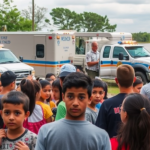Pipeline Fire in Reynosa Extinguished; Implications for the Rio Grande Valley
A dramatic scene unfolded along the U.S.–Mexico border last Sunday when a pipeline fire erupted in Reynosa, Mexico. Visible from Pharr, Texas, the blaze threatened to escalate into a larger emergency but was swiftly contained by Reynosa firefighters. Fortunately, no injuries were reported, and the fire was extinguished within an hour. This incident, while resolved without harm, has reignited discussions about cross-border infrastructure safety and local preparedness.
The Fire and Its Extinguishment
The incident began when a section of the pipeline along the Riberena Highway caught fire. This highway runs parallel to the border, making it a critical point of concern for authorities in both countries. “Our team responded immediately to contain the fire,” stated a spokesperson for the Reynosa Fire Department. “Thanks to our prompt action, what could have been a major catastrophe was safely handled.”
The cause of the fire remains under investigation, but officials are quick to assure citizens that the current situation is under control. However, given the pipeline’s proximity to the Texas border, the event has underscored the importance of binational cooperation in managing infrastructure-related emergencies.
Local Concerns and Community Reactions
While there were no reported injuries or damages in Texas, the sight of the flames from such a distance created understandable concern among Valley residents. Pharr resident Miguel Rodriguez expressed, “Seeing the smoke rising from across the border was alarming. It reminded us that events in Reynosa can easily have repercussions here in the Valley.”
This has raised questions about local readiness in Pharr and surrounding areas within the Rio Grande Valley (RGV). Texas State Representative Monica Martinez emphasized the need for cross-border emergency management protocols. “An incident like this is a wake-up call. Coordinating with Mexican authorities should be a priority to ensure the safety and security of Valley residents.”
Past Incidents and Ongoing Issues
This is not the first time infrastructure shared between the U.S. and Mexico has come under the spotlight. Previous fires and leaks have instigated public discourse on the safety and maintenance of cross-border pipelines. The incident further highlights ongoing issues related to pipeline safety—a concern for both environmental and human safety.
The latest fire incident follows recent discussions about prohibiting Mexican cattle imports into Texas, showcasing the deep interlinkages and dependencies across the border that impact the local economy and safety in South Texas.
Future Implications for the Community
The Reynosa pipeline fire opens discussions about potential policy changes aimed at improving cross-border resource management. Improved surveillance, technological monitoring systems, and rigorous safety inspections are on the table as long-term preventative measures.
Future collaborations between Texas and Mexican officials could pave the way for groundbreaking agreements on infrastructure safety. Dr. Ana Cardenas, a Texas A&M University expert in cross-border relations, stated, “This incident could catalyze the establishment of more robust binational safety protocols. Such measures would ensure that both sides are prepared for similar situations.”
The Broader Picture of Local Preparedness
The Rio Grande Valley, known for its robust community and economic activities, is no stranger to challenging weather and environmental conditions. Recent forecasts by The Texas Tribune highlighting the risks of wildfires, floods, and freezing weather further highlight the need for comprehensive preparedness strategies not only for natural disasters but fires like the recent one in Reynosa.
Further training and awareness programs could be implemented to educate Valley residents about emergency responses relevant to cross-border infrastructures. Local authorities in South Texas, equipped with advanced technology and rapid-response frameworks, are key to protecting the community from cross-border threats.
Local Resources and Guidance
In anticipation of future incidents, Valley residents are encouraged to stay informed through local news channels and participate in community safety programs. The Reynosa incident serves as a reminder of the importance of preparedness. For more information about emergency protocols and safety planning, residents can contact the local emergency management office or the Pharr Fire Department for guidance.
The successful containment of the Reynosa pipeline fire is a testament to effective emergency response but also serves as a catalyst for necessary improvements in cross-border coordination. Stakeholders across the community are urged to engage actively in safety discussions, ensuring that preparedness does not stagnate with the extinguishment of a single fire, but instead evolves to meet future challenges.
Overall, while the fire was extinguished without tangible harm on the U.S. side, it reasserts the importance of vigilance and readiness—a lesson that resonates deeply with the Valley’s collective spirit of resilience and preparedness in facing future adversities.







